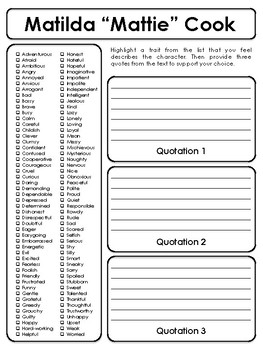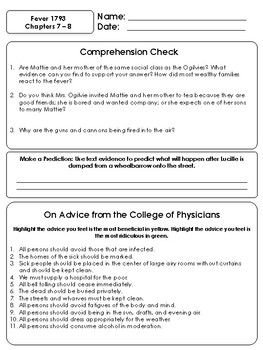Fever 1793 Novel Activities
TheBookWrangler
12.7k Followers
Grade Levels
4th - 8th, Homeschool
Subjects
Resource Type
Standards
CCSSRL.4.1
CCSSRL.4.2
CCSSRL.4.3
CCSSRL.4.4
CCSSRL.4.9
Formats Included
- PDF
Pages
62 pages
TheBookWrangler
12.7k Followers
Description
These novel activities supplement and help guide your instruction of the historical fiction novel, Fever 1793 by Laurie Halse Anderson. This is a 62 page resource with 60 useable pages! Activities are based on the common core with a focus on finding text evidence to support ideas and opinions. Engaging activities will keep your kids focused on theme; exploring figurative language; describing characters, settings, and events; analyzing and evaluating characters; summarizing using tweets; and so much more. This pack includes 15 pages of comprehension checks. Each page covers 2 chapters from chapter one to the epilogue. Don't bombard your students with endless questions that drain the enjoyment from reading! These comprehension checks allow you to assess student understanding quickly through multiple choice and written response without overwhelming you or your students! You and your students don't want to miss these activities that are perfect for early finishers; center work; homework; classwork; independent, partner or group work. A must-have resource!
Total Pages
62 pages
Answer Key
Not Included
Teaching Duration
N/A
Report this resource to TPT
Reported resources will be reviewed by our team. Report this resource to let us know if this resource violates TPT’s content guidelines.
Standards
to see state-specific standards (only available in the US).
CCSSRL.4.1
Refer to details and examples in a text when explaining what the text says explicitly and when drawing inferences from the text.
CCSSRL.4.2
Determine a theme of a story, drama, or poem from details in the text; summarize the text.
CCSSRL.4.3
Describe in depth a character, setting, or event in a story or drama, drawing on specific details in the text (e.g., a character’s thoughts, words, or actions).
CCSSRL.4.4
Determine the meaning of words and phrases as they are used in a text, including those that allude to significant characters found in mythology (e.g., Herculean).
CCSSRL.4.9
Compare and contrast the treatment of similar themes and topics (e.g., opposition of good and evil) and patterns of events (e.g., the quest) in stories, myths, and traditional literature from different cultures.





